| 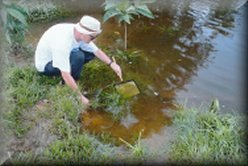
'From the Armchair to the Amazon'
Dr David Sands reports on the making of a TV program for fishkeepers
Flooding, endless days of rain, high water levels, fishes harder
to catch. Sounds like the UK but this is October-November in
the middle of the Rio Negro in the Brazilian Amazon. We are
in a freshwater ocean, travelling days on end to reach the Rio
Branco. It's the dry season yet water levels are 10-20 foot
higher than normal. While the UK is having the wettest Autumn
since records began the Amazon appears to be experiencing a
similar weather pattern. Maybe there is something in the global
warming science is currently recording. 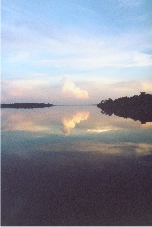
'To the Ends of the Earth' - Fish People in the Amazon
I'm on location in South America with four fishkeepers and three
anglers for the making of 'Fish People' go to the Amazon. It's
a fairly big production from Survival Anglia television with
a full film crew to produce a program in their Channel four
series 'To the Ends of the Earth'. We've got four weeks to fulfil
our fishkeeping aspirations or angling dreams or just enjoy
the Amazon. Some of PFK readers may remember the 1989 TV program
called 'Fish People. I'm the only 'survivor' from that film
which documented various people and their obsession with fishes.
My doctorate research at Liverpool University involved catfishes
from the Upper Rio Negro tributaries and I had made my last
trip to Brazil to catch and study those catfishes in nature.
My first trip to Brazil in 1979 to catch Corydoras barbatus
featured in PFK.
'The cast'
However, I'm not the only person on this current trip to have
Brazilian experience. John Chalmers, of Hobbyfish, and Colin
Anderson, a discus keeper, have been a couple of times in recent
years. I brought John to Brazil for his first experience in
the Amazon during my research period in 1992. On their most
recent trip, John and Colin had travelled to look at a fish
conservation 'Project Piaba' fronted by Dr Labbish Chao in Manaus.
The idea was that John and Colin would contribute to research
by collecting fishes with Dr Chao. However, despite what had
been promised they were disappointed at the time to find that
they were simply 'make-weight tourists' who were not encouraged
to participate in real research.
Now 'things' were to be different. John had promoted the idea
of a fishkeeping program to Survival Anglia right from the start
and, thanks to him, we would have four weeks to explore the
four million square miles of Amazon to find exciting fishes.
Joining us on the trip is Kathy Jinkings, once a familiar name
to readers of aquatic magazines through her IT links, articles
and authorship. Her book about Bristle Nosed catfishes led to
me supplying photographs and research material.
Finally, a latecomer to the program (which had been in the planning
for over a year) was Derek Lambert who is known for his enjoyment
of livebearing fishes and articles on the same. For the latter
two, this is their first time in the Amazon although Derek has
made a number of collecting trips to Mexico. Finally, there
are three serious anglers, Giles Jackson, Chris Thring and Henry
Trotter. They've got rods inside containers that look like rocket
launchers and a whole array of lures some of which look like
creations from a play station game. We haven't met these fishermen
before and there is a kind of 'them and us' at the start of
our journey. The trip only gets going in Manaus, the port town
in the central interior of Brazil. Will we clash with them over
fishkeeping versus fish hooking? Will they clash with us because
they are after big river, monster 'Peacock Bass' (Cichla ocellaris)
and we want small catfishes, cichlids and tetras from rain forest
creeks. They were the uppermost questions on a few minds.
Fish mortuary
We've met Miguel who has arranged the boats and the trip. However,
we have not set off up the river. Our first day's filming is
into the covered fish market, partly a Victorian styled iron
structure and partly rows of counters littered with dead fish.
It's 6 am, an hour after the break of dawn, and the sun is already
hot. I am leading the anglers off the 'Iguana', our boat, onto
the busy landing, down a broad plank and onto dry land, past
boatloads of fishes. We are climbing the steps of the port wall,
crossing a busy road and strolling into a fish mortuary. I am
chatting freely about the huge 'headless' catfishes (they are
all dressed for cooking), monster fruit eating fishes, piranha,
giant characins and a few hundredweight of 'Peacock Bass' spread
out before us. I'm thinking this is a mortuary for fishes and
I can't remember if I said it to camera. The director's just
told me that there's no narrative to the documentary. The camera
will film what we do and see and we will talk to camera about
our thoughts. There is at least five people behind the TV camera
including a producer, a director, a cameraman, his assistant
and a 'soundman'. We are all finding it difficult to perform
on cue. The fish market is a predictable start for the filming.
I am now going back to the boat, moored with countless others
and asking the 'aquarists' to take a look at the fish market
for the film. I am now leading them down the same route from
the boat to the market. It's getting very warm. The director
has just told me I'm not needed for filming so I am strolling
my way back to the 'Iguana'. However, I'm on the wooden jetty
and there is no boat - both of them have vanished. This is one
of a number of 'signs' that communication is currently not high
on anyone's list. 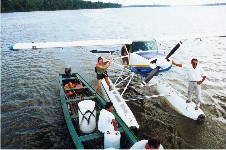
Birthday on the river
Today it's Giles's birthday. Both he and John are to enjoy an
Amazon birthday during this trip. Lots of beer and a very late
party are now binding us together. I've got my guitar and I'm
playing 'All along the Watchtower' in a style crossed with Dylan
and Hendrix (my opinion) but everyone says they love the live
music and I feel O-K.
Finally, the next day we are on our way. The boats (the film
crew have their own boat) are towing metal canoes and ploughing
a slow line against the mighty Rio Negro water flow. This is
after days of waiting while the 'Iguana' and the unfortunately
named sister ship, 'Bumerange' (the film crew's boat) have been
completely stocked up with fresh fruit (un-ripened bananas etc)
beer and fish etc. We are travelling under a full-throated thunderstorm
but its definitely time to be intrepid after one too many days
in the port.
After a bit of a long haul we've now stopped at a splendid lodge
on a river offshoot that is used as a base by Miguel's eco-tourists.
It's a Saturday so I am wearing my Blackburn Rovers shirt. Derek
and Kathy are net dipping and appear to be thoroughly enjoying
themselves catching splashing tetras. Derek is desperate to
catch something rare and is 'seeing' new species even if they
are not there. You can't beat enthusiasm.
Suddenly the director and the producer are announcing to us
all that it's now 'our trip'. We don't have to be tourists -
they are saying - we can dictate what we want to do and where
we are going. It feels like 'Big Brother'.
Now, we've got a meeting because there are several agendas on
board. There is the anglers, aquarists, film crew and boat crew.
Who will connect them all together so we know what going on?
I volunteer to be a liaison person and I'm voted in but there's
trouble in the camp. Derek doesn't want this and there is drama
of sorts. I've just tackled Derek and he's told me he doesn't
like meetings and his role as editor of a fishkeeping magazine
may be compromised if he's seen with me. I think he should of
thought about that before he begged the producer to be involved
in the program.
In discussions with the producer (who did a research trip of
the region a year ago) it now develops that we are committed
to some aspects of the trip. Firstly we are going to Barcelos,
a small Amazon town that has grown up with the ornamental fish
trade. The town is situated on the river and we are going there
to look at Dr Chao' s place (he's vanished somewhere in America
- probably heard we were coming). We are also committed to looking
at an fishing community on an island. However, the fisherman's
village/island is now under water. Everyone shrugs shoulders.
This is supposed to be the dry season!
It's now been more than a week of travelling and we aquarists
haven't gone up a single collectable creek. The anglers are
catching piranha and bits but not anything like a two-three
foot Peacock Bass. The river is just too high.
Lake catfishes
Finally on the Rio Negro we have moored at a small tree populated
Island. It is flanked with smooth rocks and the river flow looks
awesome as it swirls around the exposed boulders. There are
some wonderful knots of deadwood branches and roots on the island
that some aquarists would probably pay a ransom for. Miguel,
the owner of the boats and lodge, is gently informing me that
he ships 'container loads' of this wood to Japan. If you've
read the 'Nature Aquarium World' books with writing and photography
by Takashi Amano you'll know why his aquascapes with branches
look so wonderful. One of the boat crew has surfaced with a
saw and Miguel is instructing him to cut off a particularly
eye-catching piece of the tree. I am cooling off in the water
after doing a piece to camera. Swimming out from the island
into the current of the river is suddenly frightening. This
is the first time I have ever attempted this and I am struggling
to keep up with the flow. It's a bit like running on the spot.
I make a note never to swim in the flow of a major river again.
We are now travelling into a lagoon area known as Lago Cureru
and it looks like a really cool place to catch our types of
fishes. On the lake bank, amongst the partially flooded trees,
there is a tiny open place where the trees are not crowding
each other and we can land the canoes. Now we are catching fishes
in and around the substrate of leaf litter. We are paddling
in the water and, in the excitement all the 'people politics'
disappear. It is almost possible to forget that we are being
filmed.
Colin has just shouted out. He's within inches of a foot long
red tailed catfish that is hovering below the water surface
right in front of him. John is now sweeping around, rather bravely,
in chest deep water, trying reach Colin and help to net the
catfish. I've just poked my oar in and they've lost it. In the
near distance Kathy is busy doing a full survey of the fishes
in the shallow water leaf-litter and she's seems to be finding
lots of weird catfishes. There are hundreds of small tetras.
I'm catching inch long juvenile banjo and tiny talking cats.
One catfish is Amblydoras hancocki, not rare, but it is lovely
to see these babies. The adults would have spawned June/July
in the floods and now in October, the juvenile talking cats
alongside other species are now venturing out from the leaf
litter. All-in-all this is a great moment. Plenty of 'whoops
of delight'. I am running from the water to the bankside to
help identify whatever Derek, Colin, Kathy and John are catching.
I want to photograph the fishes later on the boat. My small
photography tank survived the journey from Lancashire to the
Rio Negro inside my guitar case and it is now to be put to good
use. We're all pleased with the catch. We've waited too long
to be here right now.
It's proving to be too hot to fish between the hours of 10 am
and 4 pm. So it's up at the crack of dawn, siesta between those
times and then fishing into darkness (with some night fishing).
I've got the best cabin on the boat. I was the last on the boat
and had last choice (honestly). Everyone, except me, assumed
my cabin belonged to the captain. There are mutterings. But
the humidity is sky high and there's no air conditioning. If
the generator's on (sounds like pneumatic drill at full throttle)
then I've got a fan that wafts some air into the place. We are
drinking wholesale quantities of bottled water, beer and cans
of pop. 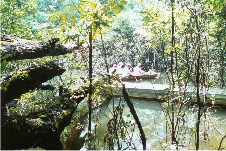
Reds in the River
We are now at the mouth of the Rio Branco. The water is brown
as opposed to black. There is also a different kind of greenness
on the river bank. Large grasses, fern trees and trees. The
Rio Negro banks are endless lines of the same trees, trees and
more trees. Colin (now something of an expert at seeing what
others are missing) is pointing to a baby red tail catfish a
foot or so down in the water among the submerged branches of
a fallen tree. I am just drawing a thumbnail sketch of the habitat
in my notebook. I will add it to my scribbles within 'The Emperor
of the Amazon' A handbook of the Red Tailed Catfish. My net
just scared it away. Within the hour, another shout erupts from
Colin. The little blighter has returned to the same spot just
to tease me. This moment is revealing in that it confirms that
juvenile Phractocephalus are just as territorial in nature as
they in aquaria.
Another boat move later and we are all looking skywards down
river of the Rio Negro. A seaplane is now circling because it
is about to land on the river to allow a Canadian guy called
Oliver (commercial specimen fish collector for public aquaria)
and a Manaus based fish exporter, Eduardo (our guide), to disembark
and meet up with us. According to Derek, the arrival of these
two seasoned travellers means all our troubles are at an end.
I'm thinking they must know where the plug is to let some water
out of this massive Amazon river.
Once out of the small aeroplane the cameraman and his assistant
go up to film the boat and the local area. Some of us talk about
escaping back to Manaus in the plane.
Within minutes of returning to the mouth of the Rio Branco a
red tailed catfish is caught in the same spot. I am photographing
Eduardo as he holds it in a fish box. Colin is now photographing
me holding the catfish out of water. I hope his pictures come
out. The young red tailed catfish has a wound on its caudal
peduncle base and so we eventually return it to the water hopefully
for it to live fight another day.
Some of us are getting eaten alive. Not by mosquitoes (although
they are biting) but by sand flies or sweat flies - who knows
which? Some of us have got the trots. There is a rumour that
there is bacteria in the ice that surrounds the tins of beer
and coke in the cooler boxes. Now everyone is vigorously wiping
them. Suddenly four weeks on a boat in the Amazon sounds like
a very long time.
Maquari and Curubau magic
We, that is to say 'the aquarists', are now closing in on our
favourite fishes. We are fishing at a lakeside site in near
darkness and Colin has captured an Aspidoras pauciradiatus,
a tiny catfish that looks 'all the world' like a Corydoras.
However, a twin hole in the skull means that scientists know
that it's different. There's a number of species in this genus
but this happens to be one of the first species encountered
by aquarists and to be spawned and raised in aquaria (by Colin
Sykes amongst many who said they would cannibalise their own
eggs if not removed). I can remember examining preserved specimens
at the Natural History Museum in London in the 1970's that were
still catalogued as 'Corydoras pauciradiatus'. Although described
from a specimen 'said to have been collected' by Axelrod in
the Rio Araguaia - either it is a widespread species or the
location is wrong! Anyway, these lovely 'speckled' catfish are
living happily in the leaf litter at the edge of a beautiful
flooded-forest lake. There are millions of tetras, lots of weird
little catfishes and driftwood and talking cats and Hoplosternum
thoracatum - a kind of a giant Corydoras. We know from the anglers
that the lake is full of wolf fishes (Hoplias - which have been
nick-named the 'skin head fish' because they are as tough as
old boots with sharp teeth to match) and Black Piranha. From
our own 'survey' of the lake area we know there are plenty of
small to large cichlids including Apistogramma, Geophagus, the
Flag cichlid, Mesonauta festivus, pike cichlids, Crenicichla,
Hero severus, the Severum and Cichla ocellaris and Cichla temensis.
Time to write up my notebook. The secret of the Amazon is the
leaf litter. There are layers upon layers of leaves and it is
home to microcrustaceans, eggs and invertebrates. They are the
start of the food chain, from such tiny creatures and 'food'
through to the larger predatory characins, cichlids, catfishes,
giant kingfishers and eventually the Black Caiman. Without the
leaf litter there would be little cover for the small creatures.
Dancing in the dark
We are heading into the Maquari creek and it is an archetypal
Amazon rain forest river in both its shape and form. The outboard
motor has to be lifted over every submerged log and I'm out
on the front of a canoe keeping watch for them. It's like landing
an aircraft without bats. As we journey up stream Giant kingfishers
take flight off from their branches and are landing on similar
perches just ahead of us. Each hundred-metre stretch of the
creek seems to be territory to each bird. After an hour of this,
we're heading out of the creek and into a large lake area again.
There are habitats for angelfishes, discus and lots of other
fishes.
Now we are out night fishing. Our canoe is navigating the Maquari
again. My torchlight is beaming out from the brow highlights
a blizzard of insects. I am hanging one of the filmmaker's powerful
submersible-torch down and it is lighting up the golden brown
water. Black Caiman are waiting for their dinner at the water's
edge. Here at night you see them by the reflection of their
eyes in the torchlight. The wider apart the eyes are, the bigger
the Caiman. A foot apart and it can probably eat the canoe!
Eduardo is croaking at them and they are croaking back. Males
do this.
We see some fishes in the water but mainly amongst the leaf
litter. It's a bit disappointing. Our fabulous lights are now
prematurely failing (recharging not working) and we are steering
the canoe back along the Maquari to the 'Iguana' in complete
darkness. Just now we've hit a tricky clutch of submerged logs
and some of us (not me) are disembarking onto a tree-sized log
stretched across the creek. We are lightening up the canoe.
Colin is momentarily left behind in the darkness, balancing
gingerly on the log. We have a baby Caiman and a Mata mata turtle
to contend with tucked away at my feet in the bottom of the
canoe. It's all getting a bit scary. Safely back at the Iguana
we are scratching and clambering back onto its middle deck.
We are thoroughly shattered.
Islands in the stream
Now, after more Amazon ocean sailing, we are moored at a Rio
Negro island that we had visited earlier in our travels. The
difference now is the water level has dropped dramatically and
this fall in the water level has exposed more rocks. Oliver
announces he is to go catfish and stingray hunting in the dark.
I'm going to leave him to it as I decide to make notes from
the safety of the Iguana. That is until I hear whoops of success
coming from a necklace of flashlight-lit rocks. I race round
the island's edge to reach the rock area. The camera is 'rolling'
and out from the crevices is plucked a rather delightful looking
'starlight' Ancistrus. At first I've got 'Derek's disease' and
my mind is racing for an exotic identification. I am now thinking
the Ancistrus is a Leporacanthicus galaxias, the Vampire catfish,
because the white spotting is so beautiful and distinctive.
Another whoop from another part of the rocks is a signal that
another catfish is being pulled from the crevices. A cursory
glance and I think that it is Peckoltia vitatta that has been
captured. This species is recorded from the Rio Negro but I
have never collected it in this habitat - I have never been
on a trip where it has been collected. In fact, I have never
really surveyed any of these small islands because they are
so changeable. I am currently making a mental note to film the
rocks tomorrow in daylight to record 'habitat pictures' for
these lovely catfishes. I am wondering how this part of the
film will look on television because it is so exciting and the
catfishes are very striking.
There are large chunks of driftwood amongst the rocks. There
is also a clay-like mud and the exposed area reveals what appears
to be 'catfish burrows'. I am now pondering about the drastic
changes to this habitat and how this must affect the fishes.
The boulders and rock caves are sometimes sheltered from the
fast river flow and then, one day they are exposed to the atmosphere
and another, they are twenty feet under water. Such a changing
environment must demand extremely adaptable fishes. 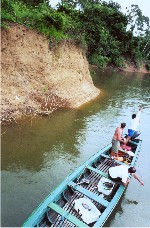
Angel aquarium
We are now putting a match to a hastily constructed bonfire
on the island in the best traditions of castaways. The plan
is for Colin and John to travel out into the lake area and catch
discus. They dare to venture out with the non re-charging flashlights
and, after a long trip into the flooded parts of the lake they
have returned with some superb angelfishes. They look like Altum
angels but that is simply because they are so large. John is
going to build an aquarium (from glass obtained before we set
out from Manaus) on the boat to house them. That way we can
take pictures and the camera crew can film these superb specimens.
They may not be discus but the wild angels, Pterophyllum scalare,
are absolutely superb.
I'm too hot and it's only 7am in the morning. Despite warnings
about black piranha I want to swim. Now, two of the boat crew
are paddling canoes at either side of me like an aquatic escort.
They don't want to see me end up as breakfast for these sharp-toothed
killers. Eduardo and Oliver have caught some massive specimens
so I know they are in the water but I need to cool down. It's
comical. I'm circling in the water and they are paddling to
keep the same pattern. I like being loved. The camera is rolling.
Now I'm refreshed and it's a new day (or is the next day after
that?) and I'm in the lakes again with the anglers. I've volunteered
to go out in their canoe and watch them fishing. The camera
is rolling and I am deliberately winding them up by telling
them they couldn't catch a cold. There is lots of 'lure caught
in the trees' because they are pitching into the lake's edge
where the big cichlids live. I am showing them how to do it
and, of course, I'm failing miserably. Now I know why I am an
aquarist and not an angler.
On the way back at the Island Henry casts into an inlet and
pulls out the biggest and most beautiful 'Peacock Bass' yet.
'I knew I'd bring you luck' I am announcing.
The aquarists minus one (Derek is poorly) are going across to
another island to night fish for catfish. We know the flashlights
are not going to last so as the sun sets in a blaze we await
our moment to fish. It is a piece of magic and madness. Nonetheless,
as darkness envelopes us we are quickly wading in the water
and there are lots of cichlids and lovely Peckoltia. I am swearing
as one 'cracking little catfish' leaps out of a crevice and
across my pond net to avoid capture. It's a lovely moment. The
four of us then set off in complete darkness back to our boat
and our own island.
This night I awake from a dream that the Beatles asked me to
play on a gig with them.
Large at the Lodge
More cruising down the river on the Iguana. It's John's birthday
and in between shooting off to the toilet I am playing 'Moonshadow'
for his unique beach party on the Rio Negro. There's also REM's
'Man on the Moon' on my playlist - am I trying to tell them
some thing? I've seen the same tree a trillion times - the Amazon
is so vast you have to be here to understand. I'm very close
to howling at the moon. There are some amongst us who might
belong in an Amazon asylum.
We've returned to the lodge after a heavy night of boozing.
The plan is to visit a nearby creek and film aquarists snorkelling
and such like. The water is said to be crystal clear.
My backside is beginning to protest at the amount of time it
is placed into a canoe. Nonetheless we head off to the 'Igarape
aquaboa' .
We are canoeing into an inlet creek from the lake and it's very
eerie. There are lots of tall tree stumps and it has the look
of a location for a Hollywood horror-thriller Southern Swamp-style.
Now it's changing. The water is clearer and the creek snakes
a full circle with beaches of leaf litter shallows on the bends.
This is where the angel fishes are being released by John and
Colin. The camera is rolling. Kathy is sat on the riverbank
and I am photographing the stream habitat (tripod in the middle
water) because this scene is the best ecology lesson yet. There
are submerged logs 'papered' in leaves and shoals of tetras
milling in and out of the underwater branches. Suddenly a massive
fish leaps, like a salmon, straight out of the water - between
me, my tripod and the canoe - and it sails over the canoe and
into the down stream section. I am 'gobsmacked'. Kathy is my
only witness. I imagine that the camera crew and aquarists must
have 'spooked' the two-foot long Cichla somewhere upstream and
in its desire to escape it has vaulted out of the water, past
me, and away.
Now Eduardo is lifting hollow logs out of the water and they
are brimming with catfishes. There are Ancistrus, Tatia (a dwarf
driftwood), a superbly coloured Acanthodoras (a talking catfish
which has just ejected venom at me on camera) and a South American
bumble bee catfish Pseudopimelodus raninus. This is one of the
best moments of the trip. This beautiful 'catfish creek' was
under our noses weeks ago. I am hurriedly putting my prescription
goggles on so that I can swim underwater to look at the fishes
in their habitat. Not content with that I've just spotted the
best log yet. I'm being filmed lifting it to the surface. 'This
will do nicely for my new Amazon aquarium' I am proudly announcing.
The producer has just given me the 'evil eye'. He is making
it clear that he doesn't want me to take a seven-foot long hollow
log back to England. It may cost a packet in excess baggage.
Well, you only live once.
Wacky Waterfall
The final part of the trip is to journey by canoes over rapids
to a waterfall stream. At our objective I am supposed to wax
lyrically for the camera about the incredible Amazon. In my
mind I am thinking that most of the original objectives of the
trip have been compromised and abandoned. However, there have
been moments of real pleasure.
At the wonderful modest sized waterfall, John is investigating
aquatic plants. He appears happy for the first time. We have
just waded upstream together to reach this place of scenic beauty
and it is a rare feel-good moment. One of the anglers and a
couple of aquarists are sitting in and around the waterfall.
Instead of anticipated tranquillity and reflection the scene
somehow reminds me of Alton Towers theme park.
Today, as I greet the New Year, the wonderful log from catfish
creek is in two pieces on a picnic bench in my back garden.
I can see it from my window as I work on my computer. Who was
it said that I couldn't get it home? Now, how am I going to
convince my family that I need an eight-foot long aquarium?
|







